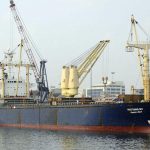1. Viscosity of Oils
Viscosity of oil is defined as the ability of the oil to flow. It is the property of the liquid which tends to prevent relative movement between adjacent parts within itself.
Generally, thicker the fluid, higher is its viscosity; whereas thinner liquids have lower viscosity.
2. Viscosity Index
Viscosity Index is a term which is mainly related to marine lubricating oils. It can be defined as the change in viscosity of the oil which takes place as a result of change of temperature.
Higher the viscosity index of the lubricating oil better is the quality. This means that lubricating oil with higher viscosity index has only a small change as a result of large temperature difference.
As a general practice, various additives are added in the oil to improve the viscosity index of the lubricating oil.
Viscosity index is a dimensionless number.
3. Cloud Point
Cloud point is the term which is related to the wax formation in the oil.
Cloud point indicates the temperature at which waxes begin to form in the oil.
Gradually, the wax formed crystallizes and clogs the filters. The cloud point helps in finding out the tendency of the oil to form wax.
4. Pour Point
Pour point of the oil can be defined as the temperature at which the oil stops to flow.
Pour point is lowered using additives known as pour point depressants.
5. Flash Point
Flash point of oil can be defined as the lowest temperature at which the oil will give off sufficient inflammable vapour to produce a flash when a small flame is brought to the surface of the oil.
6. SAE Number
SAE number of the oil indicates its viscosity based on classification involving two temperatures. Every lubricating oil comes with a specific SAE number. The Society of Automotive Engineers is responsible for the classification of SAE numbers.
7. Total Base Number (TBN)
Total Base Number (TBN) can be defined as the measure of reserve alkaline additives that are put into the lubricating oil to neutralize the acids. It determines how effectively the acids formed during the combustion process can be controlled.
Higher the TBN better is the capability to fight oxidisation and corrosion, and to improve viscosity characteristics. It also allows longer operating period between lubricant changes under harsh operating conditions.
Diesel engines burning low grades of fuel show high rate of liner wear as low grade fuel have higher sulphur content. This high sulphur content leads to corrosive wear to the liner surface. Thus, alkaline lubricating oil is used to protect the liner surface against corrosive attack by neutralizing the sulphur derivative compounds.
The TBN is generally between 8-10 for marine lubricating oils.
8. Total Acid Number (TAN)
Technically, the total acid number (TAN) of the oil indicates the deteriorating condition of the lubricating oil. Higher the TAN, more acidic is the lubricant, and further are its chances of getting more deteriorated.
TAN also indicates the potential of the oil to cause corrosion problems, leading to component failure. The TAN should not be more than 2 for marine lubricating oils.


